| Orbach
Meets Lab Employees, Reassures Lab of UC Contract
Orbach Meets Lab Employees,
|
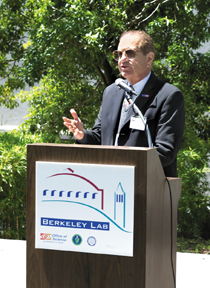 |
Speaking on the outdoor cafeteria lawn stage under the sun-dappled shade of a clear spring day, the Office of Science director took a break from his day-long series of roundtable discussions with Lab leaders to talk to his audience about the tasks ahead. One is to complete the next management contract for Berkeley Lab.
“This one will be different from the past,” he said. “It will be performance-based, leading to greater flexibility in the way you manage your resources. It will also have ‘over-the-top’ rewards for beyond-quality performance. And it will be based on standards which you can construct and develop without interference from the Office of Science or the DOE.”
This new “best practices” contract will have to await the outcome of the negotiations at Pacific Northwest National Laboratory, which is first in queue for refurbishing. In the meantime, Berkeley Lab’s current contract has been extended until August 31, when Orbach said he hopes the new one will be ready to go.
He also talked about his visit last week, with its “atypical” agenda. Orbach and his staff are in the midst of crafting a 20-year plan for facilities of $50 million or more, and his discussions here and at other labs are helping to inform those judgments.
“We’re gathering ideas from each of the labs, getting their near-term view of what they’d like to accomplish, and then the consequences of that,” he said. “Our decisions will all be predicated on the quality of science it will produce.”
He noted a special interest in research “lacking boundaries and with interaction between disciplines,” and he cited Berkeley Lab as a model for this type of activity.
Programs he heard about in the day-long series of conversations included genomics and Berkeley Lab’s response to the DOE’s Genomes-to-Life initiative, particle astrophysics and the supernova satellite project, soft x-rays and ultra-fast science at the Advanced Light Source, new materials and nanotechnology, carbon sequestration and subsurface remediation, and new frontiers of scientific computation. Lab Director Charles Shank spoke about integrating research through strategic goals.
Orbach said he is buoyed by Congress’ current commitment to develop an energy bill with four year’s worth of funding authorizations — the first such legislation in 15 years. He is attempting to fit the 20-year facilities plan and its accompanying operational needs within that authorization.
“Congress is very concerned about the budgetary constraints that the Office of Science has been under,” he said.
Orbach was asked by one employee how he plans to prioritize 46 capital projects from all the labs in his facilities plan.
“I will be the most unpopular person in the country,” he laughed. “My decisions [will be made] entirely on the basis of the science — what will that facility add to the knowledge and the intellectual contributions of our country?”
In a few weeks, Berkeley Lab and its sister institutions will find out how they fared, and what the next 20 years might look like.
By Monica Friedlander
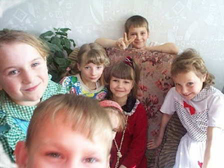 |
The journey for these children starts in orphanages in remote villages in the heart of Russia. Many of them have never seen a television, ridden in a car before, or remember a mother’s hug. It continues with a trip half-way round the world, across continents, oceans, and political divides. And for most of them it eventually triumphs with the reward of a lifetime: a home and a family of their own in America.
This miracle of love, however, could not happen without the extraordinary dedication of organizations such as Family Hope, which is coordinating four-week “American culture camps” for underprivileged Russian children available for adoption; nor without the help of prospective adoptive parents and volunteers such as Alek Shestakov, a computational physicist at Lawrence Livermore Lab who also works as a guest at Berkeley Lab.
Shestakov, who was born in Serbia of part Russian heritage, hopes that one of the children who will visit the Bay Area this summer will become an adoptive brother to his eight-year-old son. Until then, he is working with Family Hope Bay Area to help find host families and other volunteers to help with the 39 orphan children who will arrive this summer — the largest number ever to visit one area under this program. But with just weeks to go till the children arrive, much still needs to be done.
“We need to find host families for these children and their escorts,” Shestakov says. “I can’t think of anything more worthwhile than creating an opportunity for orphaned children to find a loving family.”
Family Hope is now accepting applications for two summer sessions — one starting in early July and one in late July or early August. Camp locations are being explored in the Walnut Creek and Livermore areas, although the location of host families will determine the final camp locations.
To host a child or otherwise become involved with this program, register online at FamilyHopeBayArea.org.
The children, aged 4 to 12, will spend their time here with American families in an environment conducive to forming bonds with potential adoptive parents while enjoying daily activities in a YMCA-style day camp. The program’s goal is for the orphans to be adopted either by their host family or another family who meets them during their visit here.
“Kids in the 4-to-10 age range are very adaptable,” says David Avilla, Family Hope coordinator for the San Francisco Bay Area and adoptive father to five Russian siblings. “They adapt very well to the new environment and learn the language quickly. Adopting an older child is not as difficult as people believe. In fact it gives you an opportunity to get to know the child and assess their character the way you can’t with a baby.”
For Shestakov, this is the perfect age range. The idea to bring in a new family member was actually initiated by his eight-year-old son Adrian, who wanted a playmate. After considering various options, Shestakov and his wife Janet decided on the Family Hope program.
“Once these Russian children are here, they are all ready to be adopted,” Shestakov says. “All parental rights have been severed.”
Family Hope programs are offered through International Family Services (IFS), a nationwide, nonprofit child placement and adoption agency which last year placed over 250 children from eight different countries.
Host families do not need to adopt the children, and prospective parents do not need to be hosts to adopt, although the host is given priority in the adoption process.
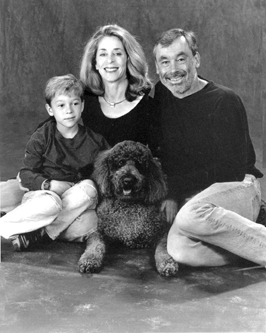 Alek Shestakov, pictured with his wife Janet and son Adrian, are hoping to adopt a Russian orphan from the Family Hope program he is helping organize in the East Bay. |
Volunteers are also needed to host a few escorts who accompany the children and to help with a variety of camp activities. Also needed are volunteer Russian language translators.
There are few requirements to become a host family. The child must be provided a bedroom or be able share one with other children of the same sex. And the host must be able to transport the child to day camp every day, unless arrangements can be made for car pooling.
Host families receive photographs of the children and medical information, and will participate in a one or two-day orientation in June.
Upon completion of the program, all children return to Russia as required by law, since they come here on a cultural exchange visa. The lucky ones who find families will only wait for the adoption paperwork to come through before being reunited with their adoptive parents.
The other children return to Russia for good. And like most other orphans there, when they graduate from those institutions at age 16 or 17 they will have little to look forward to. With no education, money, or families to go to, most will end up on the streets.
Programs such as Family Hope are trying to reduce the number of youngsters who will face this fate.
“I believe this is the biggest blessing — experiencing God’s care toward orphans by creating opportunities for kids and families to connect,” Avilla says.
To learn more about the program, contact Family Hope Bay Area at (408) 848-2439 or visit http://www.familyhopebayarea.org/.
By Paul Preuss
In the May 9 issue of Science magazine, Don DePaolo and Michael Manga, members of Berkeley Lab’s Earth Sciences Division and UC Berkeley’s Earth and Planetary Science Department, defend a basic tenet of geology against a rash of recent criticism.
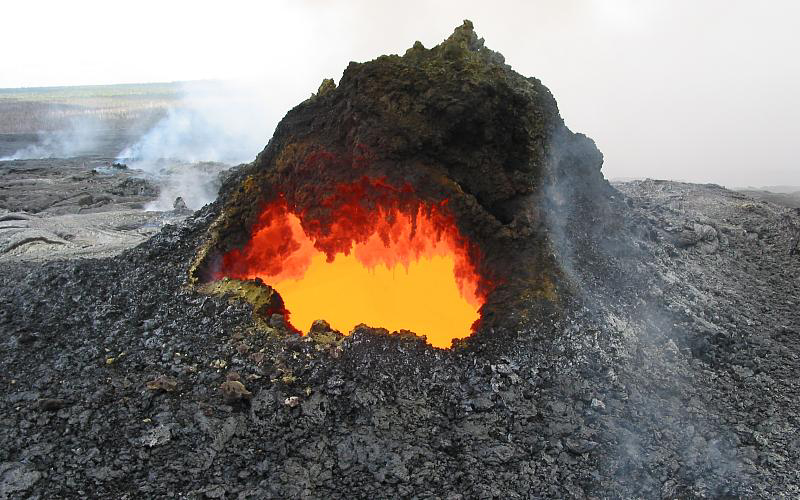 The hotspot under the Hawaiian Islands exudes more lava per unit area than any other place on Earth. Photo courtesy of the U.S. Geological Survey |
The hot rock that drives volcanoes such as those of Hawaii and Iceland and the geysers and mudpots of Yellowstone, they hold, is fed by plumes of melted rock rising from deep in the mantle, as deep as Earth’s core. These hotspots cannot be explained by plate tectonics.
The disagreement goes to “one of the central problems in Earth science,” says Manga. “Because Earth’s core cools through plumes, understanding plumes is essential to understanding the energetics and evolution of the core.”
Although the core is hidden under almost 3,000 kilometers of rock, it plays a crucial role in shaping our everyday affairs. Its currents of liquid iron give rise to the planet’s magnetic field — which has often collapsed and reversed itself (see Currents, April 18, 2003) — and core heat is one of the principal engines driving change on Earth’s surface.
Propelled by heat from the core and radioactive decay in the mantle, tectonic plates spread and collide to cause earthquakes, mountain-building, and volcanism. But mantle plumes — whose existence most Earth scientists have embraced for over 30 years — act directly, creating immense structures from flood basalts and feeding long-lived hot-spots that can produce island chains thousands of kilometers long.
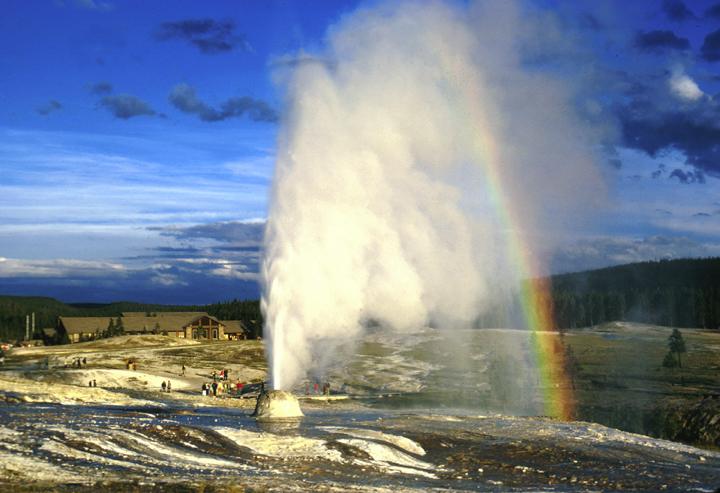 The geysers of Yellowstone are thought to be fueled by the same mantle plume responsible for the Columbia River basalts to the west. |
Estimates of the number of hotspots in the world range from a handful to more than a hundred, but most scientists agree to a list of several dozen. Some, like Hawaii and Yellowstone, are far from plate boundaries; others, like the one under Iceland, lie much deeper than the source of melt that erupts at mid-ocean ridges. But while plate movements can be observed directly, plumes must be inferred from seismic signals — notoriously fraught with uncertainties of interpretation.
At the annual meeting of the American Geophysical Union in San Francisco last December, seismologists who deny the seismological evidence for plumes under Yellowstone and Iceland led a group of vociferous “plume bashers.” It was a short step to the claim that plumes don’t exist at all.
“It seems to me that the critics don’t understand some aspects of the basic problem,” says DePaolo. “For example, they claim that the mantle beneath Iceland is not hot, and the mantle beneath Yellowstone is not flowing upward. My view of the data in the papers they cite is that it leads straight to the conclusion that the rock is hot and flowing upward, just as we expect for mantle plumes.”
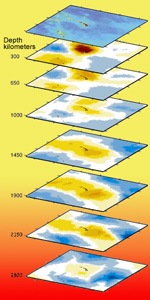 Finite-frequency tomography allows high-resolution mapping of the mantle plume that channels heat from the core to the Hawaiian Islands. Illustration: Guust Nolet |
DePaolo and Manga cite the strong evidence for deep plumes under several hotspots. In Hawaii, for example, so much magma is produced in a circle less than 100 kilometers across that it must be moving upward at some 50 centimeters a year — ten times faster than the movement of crustal plates. Under Hawaii the lithosphere is 80 kilometers thick; for melted rock to exist that deep, the temperature must be 200 to 300 degrees Celsius hotter than the surroundings.
Geochemist DePaolo studies the chemical signatures of geological structures. The chemistry and isotope ratios of the lavas of Hawaii and other hotspots point to their deep origin — an origin different from that of the relatively shallow-melt basalts of the mid-ocean ridges.
Geodynamicist Manga studies volcanism and other fluid processes using a variety of techniques, including physical models — what he calls “neat stuff in the lab.” By heating a fish tank filled with motor oil and soy oil, Manga has shown how plumes can form from a superhot layer of rock at the core-mantle boundary.
Like a gigantic growing mushroom, a plume breaks off and slowly rises through the mantle. At the surface it can burst out in titanic flood basalts. Having reached the surface, its thin tail can stay in place for 100 million years or more — forming an open pipe from the core-mantle boundary, through which hot rock continues to rise. A plume’s persistence is a natural physical explanation for the stability and longevity of hotspots.
DePaolo and Manga do not insist that all hotspots are caused by deep mantle plumes; some may owe their persistence to different mechanisms. Yet the poor resolution and uncertainty of seismological imagery is a weak argument against the existence of those plumes for which other evidence is strong.
“Many natural phenomena were well understood before instruments became sensitive enough to measure them directly,” says DePaolo — and that looks to be the case with seismological imaging, too.
DePaolo points to the work of Guust Nolet of Princeton University and his colleagues, who recently developed seismological imagery with much higher resolution. With it they have mapped a thin column of high temperature in the mid-Pacific all the way down to the core-mantle boundary, 2,900 kilometers beneath the active volcanoes of Hawaii that sit atop it.
By Lynn Yarris
MTV came to Berkeley Lab to dispel an urban myth about mice, and its production crew members were as impressed with what they saw and heard here as only the MTV generation could be.
“This place kicks a**!” enthused Cecil, a young woman reporter who interviewed Elaine Gong of Berkeley Lab’s Life Sciences Division for a segment on MTV’s Big Urban Myth show aimed at uncovering the truth: Do mice really prefer cheese above all other foods?
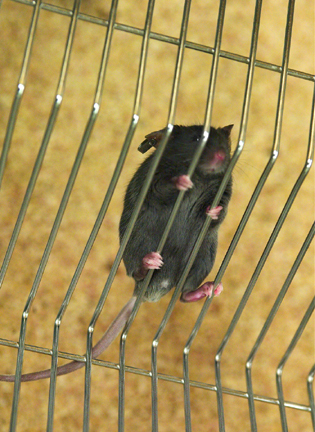 |
“My hypothesis would be no, mice are equal opportunity eaters,” Gong declared on camera before the test began. Hers was more than just a guess. Gong runs the mouse facility for Eddy Rubin, a Berkeley Lab scientist whose research with genetically engineered mice has led to important new medical insights into such human afflictions as atherosclerosis, Down syndrome, and sickle cell disease. It apparently has also brought him to the attention fo MTV.
But Gong did not base her hypothesis entirely on lessons learned from her daily interactions with mice. No, like any good scientist not wanting to be surprised in front of a television camera, she did some preliminary testing prior to the arrival of the MTV crew.
MTV’s Big Urban Myth show, which regularly airs on Tuesday nights at 10:30 p.m. PDT, is dedicated to “investigating the facts” behind such stories as white alligators residing in the sewers of New York City, baseball caps causing baldness, or mice preferring cheese above all other foods.
After Rubin was first contacted by MTV and it was agreed that Gong would do the segment, she set up the experiment that was to be aired and ran a couple of trials of her own. She used four mice that had been trained to go to certain areas in their cages for food. The choices Gong offered them for this test, in addition to cheese, were peanut M&Ms, Marshmallow Peeps, bacon, and a mix of cereal grains scented with garlic. In Gong’s off-camera trial runs, the mice showed a preference for the peanut M&Ms, with cheese second, followed by bacon and the cereal grains. Unlike Gong and other members of Rubin’s research group, the mice did not fancy the marshmallow peeps.
The three-member MTV crew came to Berkeley Lab on Thursday, May 8. In addition to the aforementioned Cecil, the crew included Mark on the camera and Dave on sound. All three were “stoked” by the requirement that they don gowns, caps and booties before entering the facility to protect the mice from human germs — so stoked that Cecil, Mark and Dave asked Berkeley Lab photographer Roy Kaltschmidt to take their pictures in their science garb.
Properly attired, their equipment sprayed down with an antiseptic, the MTV crew entered the mouse facility with Gong. The mice were ready: two cages, two mice in each; and the food offerings were prepared: the exact same choices as Gong had provided in her previous trials.
With the camera rolling and Cecil asking the questions, Gong explained how the mice are used in science, speculated on how the story of mice preferring cheese might have gotten started. She made her prediction, then placed the food choices in the cages and started the test.
All four mice went straight for the cheese immediately and never looked back. Throughout the test, all four paid little or no attention to any of the other offerings. That’s showbiz!
The 2003 class of fellows and foreign honorary members of the American Academy of Arts and Sciences includes Nobel laureats such as Donald Glaser, Secretary General of the United Nations Kofi Annan, and celebrities such as Walter Cronkite. Sharing the stage with these dignitaries this year are three Berkeley Lab scientists who hold joint appointments at UC Berkeley: Carolyn R. Bertozzi of Materials Sciences, William E. Dietrich of Earth Sciences, and Jennifer Doudna of Physical Biosciences.
“Election to the American Academy is an honor that acknowledges the best of all scholarly fields and professions,” said Academy President Patricia Meyer Spacks. “Fellows are selected through a highly competitive process that recognizes those who have made preeminent contributions to their disciplines.”
Carolyn Bertozzi and her group study cell surface interactions that contribute to human health and disease with specific projects in the areas of cancer, inflammation and bacterial infection. By combining the use of organic chemistry and molecular and cell biology, they investigate key biological functions that can lead to the development of new therapeutic strategies. Bertozzi was named a MacArthur Fellow in 1999.
William Dietrich of Earth Sciences and a professor of earth and planetary sciences at UC Berkeley, focuses on seeking a “mechanistic, quantitative understanding of the form and evolution of landscapes,” and researches tools to tackle environmental problems.
Last week Deitrich also became one of 72 new members elected to the National Academy of Sciences — one of the highest honors that can be accorded a U.S. scientist or engineer.
Jennifer Doudna is a Howard Hughes Investigator and professor of biochemistry and molecular biology at UC Berkeley. Her research focuses on ribozymes and RNA machines. She studies the structures and mechanisms of RNA catalysts and the roles of structured RNA molecules in protein secretion and translation initiation.
The American Academy of Arts and Sciences was founded in 1780, and has elected as fellows the finest minds from each generation — from George Washington and Ben Fran-klin to Albert Einstein and Winston Churchill.
A total of 187 fellows and 29 foreign honorary members will be inducted this year. The ceremony will be held at the Academy’s headquarters in Cambridge, Massachusetts, in October. — Monica Friedlander
Published twice a month by the Communications Department for the employees and retirees of Ernest Orlando Lawrence Berkeley National Laboratory. Ron Kolb, Communications Department head.
EDITOR: Monica Friedlander, (510) 495-2248, mailto:msfriedlander@lbl.gov
STAFF WRITERS: Lisa Gonzales, 486-4698; Dan Krotz, 486-4109, Paul Preuss, 486-6249; Lynn Yarris, 486-5375
CONTRIBUTING WRITERS: Jon Bashor, X5849; Allan Chen,
X4210
FLEA MARKET / CALENDAR: 486-5771, mailto:fleamarket@lbl.gov
/mailto:currents_calendar@lbl.gov
Lawrence Berkeley National Laboratory,
Communications Department,
MS 65, One Cyclotron Road, Berkeley CA 94720
(510) 486-5771 Fax: (510) 486-6641
Berkeley Lab is managed by the University of California for the U.S. Department of Energy.
By Ron Kolb
There’s a new acronym in town, and just about everyone who requests purchases at Berkeley Lab will know it well come summertime.
It’s called “DPU,” for Distributed Procurements Unit. But what it really means is a restructured low-value purchasing system at the Lab, one whose streamlined nature and focused responsibilities grew out of the old P-Card system. You may recall that P-Cards have been the subject of intense scrutiny at Berkeley and other Labs, in part due to problems encountered at Los Alamos.
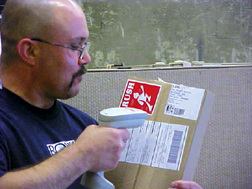 Tim Montoya scans an incoming package. All goods coming in are now bar-coded at central receiving for easy tracking and control. |
And so, here’s DPU, headed by 15-year Lab procurement veteran Ron Ball. Chief Procurement Officer Richard Arri cited Ball’s “substantial procurement experience both in public and private sectors” in making the selection. The DPU’s essential elements are 29 purchasing administrators and three team leaders, all of whom will receive extensive training in procurement procedures, and whose tasks will be entirely focused on the purchasing process.
“One of the things we found is that people really didn’t understand their roles,” said David McGraw, referring to the nearly 300 employees who bought things with P-Cards for their departments a year ago. McGraw, the Operations Deputy and Division Director for Environment, Health and Safety, headed a task force that for the last few months designed the system that would become DPU.
“We now have a much leaner set of responsibilities, and a career home for people who want to work in this function,” he said. “We’ve made the lines of accountability more clearly defined while building in a high level of flexibility.”
Human Resources Head Randy Scott, a member of the task force who is now overseeing the recruitment process for the DPU system, said documentation was a major concern when analyzing the old system. The DPU system will have the chain of requester, buyer, receiver and approver clearly spelled out. At least one purchasing administrator will be housed in each of the Lab’s scientific divisions and major operations departments.
“We tried to reduce the risks” of an inappropriate purchase, Scott said. “Our task team analysis showed clearly that the core problem was not about the people performing the work, it was a system vulnerability, due to a tremendous volume of transactions and process accountabilities not clearly being delineated.”
Standardization will now be the rule. No more making purchasing requests on post-it notes, napkins or box lids. No more hand-scribbled orders that can’t be interpreted. And when the shipments come in, they are now bar-coded at central receiving for tracking and control, then distributed quickly to the recipient. At least 25 percent of the workload will be eliminated through paperwork reduction, McGraw said.
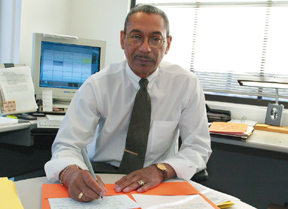 Purchasing veteran Ron Ball will head the new Distributed Procurement Unit |
The number of P-Cards, used for purchases under $5,000, has gone down from about 280 to 82, and that will reduce to 30 by the time DPU is functioning and fully staffed later this summer, according to Ball. So won’t all this down-sizing make it more difficult to get an order processed and an item acquired?
“There will be no loss of convenience for the user,” Ball said. “We’ll still have the same service level and it will have better execution, by people who are trained to do it. If anything, service should improve.”
Right now Steve Johnson of the HR recruitment team is coordinating the interviewing and selection process for the two levels of purchasing administrators – the FS2’s (senior) and FS1’s. Most of the new hires will be internal candidates. Ball said a complete program of internal and external training in the field will await them after their selection.
McGraw credits his task force for having developed the DPU process after considering risks from the previous system and models at other institutions. The plan has been forwarded to the Department of Energy as Berkeley Lab’s response to the procurement challenges at national laboratories.
He cited Scott and division business managers Carla Garbis of EH&S and Ellen Ford of Physical Biosciences as especially helpful in preparing the report. Task force members included Chief Financial Officer Bill Wasson, Administrative Services Department head Anil More, Facilities Deputy Guy Bear, and Sponsored Projects manager Jeff Weiner.
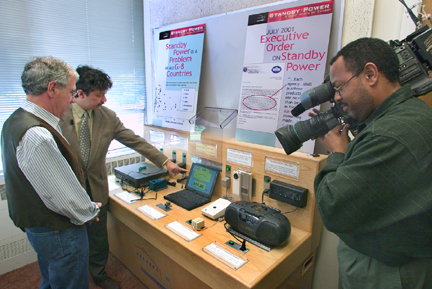
First it was the New York Times that ran a long feature about Berkeley Lab’s Alan K. Meier, a scientist in the Environmental Energy Technologies Division who determined that basic transformers — the power converters that allow electronic devices that commonly operate on 5 or 12 volts to run on 120 volts — can conspire to waste up to five percent of a home's power consumption. Even if the TVs, microwave ovens and computers are turned off, the black boxes keep running and draining power.
And last week, a TV camera crew from Channel 5 (left) came to Berkeley Lab for their own story on standby power usage. EETD’s Allan Chen (pointing) was the star of the three-minute segment that ran on the 4:30 newscast last Friday. KPIX correspondent Bill Schechner is on the left. Photo by Roy Kaltschmidt
By Dan Krotz
In the race to stay one step ahead of drug-resistant bacteria, scientists from Berkeley Lab and UC Berkeley obtained high-resolution images of a protein complex found in bacteria that repels a wide range of antibiotics.
 |
The images, which appear in the May 9 issue of Science, offer new insight into how bacteria survive attacks from different antibiotics, a growing health problem called multidrug resistance. As the team learned, these robust defenses are rooted in the protein complex’s remarkable ability to capture and pump out a spectrum of structurally diverse compounds. The research may inform the development of antibiotics that either evade or inhibit these pumps, allowing drugs to slip inside bacteria cells and kill them.
The team focused their inquiry on AcrB, a protein that resides in the inner membrane of Escherichia coli cells. It works in unison with two other proteins to rid the bacteria of toxins. Based on earlier research, they knew AcrB boasts a large cavity capable of binding with a vast range of antibiotics and other molecules. But precisely how this cavity accommodates so many shapes and sizes remained unclear. To witness this trickery, the team crystallized the protein in the presence of four molecules — an antibiotic, a dye, a disinfectant, and a DNA binding molecule — and then turned to Berkeley Lab’s Advanced Light Source (ALS). There, they exposed the crystals to extremely bright x-rays that reveal the protein’s molecular structure, including how the four molecules bind to the cavity.
The resulting images portray a hungry, indiscriminate binding site. Each molecule bound to different locations in the cavity, and each bond utilizes a different set of amino acid residues. And there’s probably room for many more types of interactions.
“The protein has a very promiscuous binding mechanism,” says Gerry McDermott, a staff scientist in Berkeley Lab’s Physical Biosciences Division.
The 3.5 to 3.8-angstrom-resolution images (one angstrom equals one ten-billionth of a meter) provide the closest look yet of a phenomenon common to all living cells: the ability to expel a diverse flotilla of toxins using one pump. In healthy people, these so-called multidrug efflux pumps play important roles. A complex called P-glycoprotein, for example, prevents the entry of toxic molecules across the mucosal surface of the intestinal tract, as well as the blood-brain barrier. But P-glycoprotein has a dark side. When overexpressed, it makes cancer cells resistant to a wide range of chemotherapy drugs.
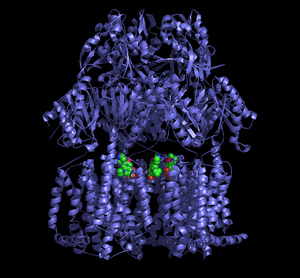 Even ciprofloxacin, an antibiotic used to treat a variety of bacterial infections including inhaled anthrax, is no match for AcrB. In this image, the green-colored drug is firmly ensnared in the protein’s cavity. |
A similar split personality is seen in E. coli and its all-purpose pump. On the good side, harmless colonies of the bacteria inhabit animal intestines. In this environment, scientists theorize AcrB’s chief function is to trap and pump out toxic bile salt. Unfortunately, a mutated form of Escherichia coli causes food poisoning. And, making matters worse, AcrB shields the bacteria from many more compounds in addition to bile salt, which explains why a broad regimen of antibiotics is needed to fight the infection.
“The protein is a bit too efficient for our own good,” McDermott says. “And our work demonstrates why. We suspect the protein’s cavity possesses areas where many types of antibiotics could be captured.”
Their research also underscores the need to pursue alternative ways of fighting drug resistance. Currently, pharmaceutical researchers combat resistance by tweaking an antibiotic’s molecular structure so it isn’t compatible with a pump’s binding site. This is difficult work to begin with, largely because antibiotics must adhere to strict potency and safety regulations that limit the extent to which they can be modified. Add to these restrictions a better understanding of AcrB’s readiness to bind with an array of compounds, including the most carefully engineered antibiotics, and the job appears even more difficult.
“Our work demonstrates that changing antibiotics to beat resistance is not a trivial task,” McDermott says.
Instead, McDermott believes their research supports another strategy in which the multidrug efflux pump is disabled. In E. coli, such monkey-wrenching is possible because AcrB connects to a funnel-shaped protein embedded in the bacteria cell’s outer membrane. This protein ejects the antibiotics trapped in the AcrB cavity. If it’s blocked, the pump can’t work. As McDermott explains, perhaps a specially designed molecule could lodge inside the funnel, rendering the pump useless and allowing antibiotics to slip inside the cell unhindered.
To support these advancements in drug design, the team will next use the ALS to more fully explore how AcrB binds with a structurally diverse range of antibiotics. They believe a fuller understanding of E. coli’s multidrug efflux pump will shed light on similar pumps found in other harmful bacteria, which could lead to better treatments for a variety of infections.
“Drug resistance has become a global problem,” McDermott says. “Our research will help design drugs that reduce resistance to antibiotics.”
In addition to McDermott, Helen Zgurskaya of the University of Oklahoma, and Hiroshi Nikaido, Daniel Koshland, Jr., and Edward Yu of UC Berkeley contributed to the research. The x-ray crystallography work was conducted at ALS beamline 8.2.2, which is funded by the Howard Hughes Medical Institute.
By Ron Kolb
Amid mutual commitments between Berkeley Lab and City of Berkeley leaders to enhance communication and partnerships, about 100 members of the Lab neighborhood got together last week to talk about Laboratory programs and initiatives.
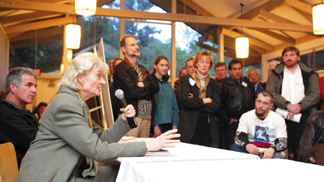 Lab architect Danica Truchlikova explaining the Molecular Foundry project to the audience assembled at the Haas Clubhouse. |
This latest effort to engage interested citizens in a conversation about the Lab took place at the upstairs meeting room of the Haas clubhouse in Strawberry Canyon. And after a rocky start marked by a few placard-waving demonstrators shouting out concerns, Berkeley Mayor Tom Bates and Lab Director Charles Shank got down to the business of the evening – dialogue and information sharing.
“We hope you will all take this opportunity to look at all of the programs represented here, and take advantage of talking with our experts,” Shank told the audience. “We look at ourselves as a very important part of the community, and this community is very important to us.”
Bates echoed the feeling, thanking the Lab for putting on the event. “We want the Lab to be a good neighbor, and we want to be a city that respects the work that goes on here. That means working together with the Lab, sharing information back and forth as appropriate, as partners.”
Shank followed with three presentations to National Merit Scholars who had participated in the Lab’s summer research program: Jonah VanBourg, Jeremy Gordon, and Kelsey Israel-Trummel.
After that, issues regarding the Molecular Foundry began to surface, as a small vocal contingent demanded to be heard. After order was restored, materials scientist Paul Alivisatos gave a slide presentation on the potential payoffs of the Foundry. He focused on two examples of nanoscale science — renewable energy sources like solar cells using nanotubes, and more effective cancer screening through cell labeling using “quantum dots” (semi-conductor crystals).
“The impact on our country and the world can be very positive,” he said of the work envisioned for the Foundry, which is scheduled to open in 2006.
About a dozen audience members, however, were more concerned about the local impacts and took turns with the microphone to state them. They questioned the environmental review process, the uses to which the research will be applied, and the health impacts of this relatively young science.
Lab officials responded to each challenge, assuring the audience that the “mitigated negative declaration,” an environmental conclusion approved recently by the Board of Regents, was appropriate for this project and rendered a full Environmental Impact Report unnecessary. They were also assured that there will be no nuclear weapons applications and no radioactive materials in the Foundry.
Offering expertise at the session were Materials Sciences deputy Mark Alper, Lab attorney Nancy Ware, architect Danica Truchlikova, and Facility Manager Joe Harkins.
Meanwhile, representatives from other Laboratory programs were dispersed around the room to answer questions from inquisitive neighbors. These included Allan Chen and Erik Page who talked about energy efficiency and the Berkeley Lamp; Rich McClure on wildland fire protection; Erik Lander and Hakeem Oluseyi on astrophysics, Charlie Osolin on the Joint Genome Project, and Rollie Otto on science education. Community Relations Officer Terry Powell moderated the session.
By Allan Chen
On Saturday, April 26, homes in San Francisco, the Peninsula and Berkeley were the site of a curious routine. At each location some 20 to 30 people wearing t-shirts with a big red heart carried paintbrushes, power tools and building materials. Some were on ladders, stripping paint or painting; some were rebuilding rotting porches and staircases; others were installing new water heaters, furnaces, toilets, disabled access ramps. Inside, volunteers were installing energy and water-efficient technology.
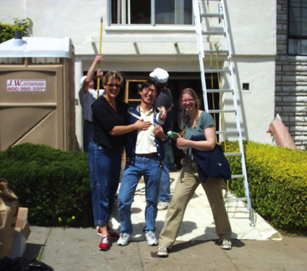 Nobuo Ogawa of Life Sciences (center) was on one of the Energy Teams, along with pals Gretchen Parker of Essex Environmental and Erica Mackie of GRID Alternatives. |
Among them were about a dozen Berkeley Lab employees and some of their spouses who participated in this year’s Rebuilding Together’s event. Some staff members joined special “Energy Teams” in San Francisco and Berkeley, while others were sponsored by UC Berkeley to work on East Bay houses.
Formerly known as Christmas in April, the organization identifies homes of needy, low-income people, often seniors or disabled, and helps make repairs which the owners cannot afford. Rebuilding Together now has chapters all over the country.
Each house has a corporate sponsor and is assigned a team captain and group of volunteers. Repairs are made on a Saturday in April. Thanks to the efforts of former Berkeley Lab post doc Lisa Gartland, Energy Teams of three to five people go from house to house to make energy efficient improvements, such as weatherstripping and caulking and installing water heater blankets, compact fluorescent lamps, programmable thermostats, water-saving showerheads and faucets, and toilet bags. A team usually visits three or four houses during the day.
This year, Energy Teams visited 17 houses in San Francisco and eight in Berkeley.
Berkeley Lab’s Maureen Cowger and Sarah Morgan of Financial Services and John Snyder of the UC Office of the President worked on an Energy Team on Silver Avenue in San Francisco. “It was a great experience to see the grateful look on the faces of the homeowners,” said Cowger.
Adriana Rocha of Materials Sciences, Mark Sippola of EETD, and Alexis Smith of Engineering worked on a San Francisco team with two other volunteers. “It was really great to realize that by doing so little one can help those who need so much,” Rocha said. “Some small actions become big ones with the combined efforts of such a great team of volunteers.”
Steve Greenberg of Facilities, Charles Williams of EETD and Judy Winzeler, the wife of an EETD employee, formed one of the Berkeley teams. All are veterans of several years of Energy Teams. “Every place is different, challenging our skills in a new way, but the energy of the volunteers and owners is great. Being tired and sore at the end of the day is a small price to pay for a rewarding and worthwhile effort,” said Greenberg.
Rebuilding Together coordinators say that next year they hope to have a larger and more organized effort in the East Bay, so be on the lookout for calls for volunteers sometime in the winter of 2004.
Current and former U.S. Department of Energy workers and contractors interested in filing claims for medical assistance for illnesses due to radiation, silica or beryllium exposure at work will have another opportunity next month to get their questions answered.
A joint DOE – U.S. Department of Labor (DOL) Traveling Resource Center will return to the San Francisco Bay Area during June 2-5. Representatives will be on hand to assist individuals with claims under the Energy Employees Occupational Illness Compensation Program Act. A similar center visited in March.
Workers who need help filling out claim forms can schedule appointments or get questions answered at the Traveling Resource Center by calling toll free (866) 697-0841, or drop in during office hours (8:30 a.m. to 6 p.m.) at the Four Points Hotel by Sheraton, 5115 Hopyard Road, Pleasanton.
The Act became effective on July 31, 2001 and provides two different types of assistance. Eligibility and benefits differ in each program. The DOL administers the program that provides a lump sum of up to $150,000 and payment of future medical expenses to current and former DOE employees and DOE contractor employees who suffer from specific diseases — radiogenic cancers, beryllium disease and chronic silicosis. Qualified survivors of covered employees, including adult children, are also eligible for benefits.
The DOE program helps DOE contractor employees apply for State workers' compensation benefits, if it is determined by an independent physician's panel that the worker sustained an illness caused by exposure to a toxic substance at a DOE facility. Benefits for successful claimants vary from state to state, but are generally a portion of lost wages plus reimbursement of medical costs.
Several facilities in this area have been designated by DOE as locations for prospective worker claims — Berkeley Lab, Lawrence Livermore and Sandia National Laboratories, and Stanford Linear and Accelerator Center.
Additionally, 17 beryllium vendor facilities were added to the covered facilities list. These include City Tool and Die Manufacturing in Santa Clara, C.L. Hann Industries in San Jose, EDM Exotics in Hayward, Electrofusion and Poltech Precision in Fremont, Hafer Tool in Oakland, Hexcel Products in Berkeley, Jerry Carroll Machining in San Carlos, Pleasanton Tool and Manufacturing, Robin Materials in Mountain View, Ron Witherspoon, Inc., in Campbell, and Tapemation in Scotts Valley.
 |
May is National Traffic Safety Month, and Berkeley Lab will be using the occasion to raise the awareness of drivers and bicyclists on the Hill about the need to slow down and respect traffic signs.
Next Tuesday, everyone who comes to the Lab in a vehicle will receive a brochure on traffic safety. And on Tuesday and Wednesday, Lab safety officials and police officers will be in the cafeteria lobby during lunch hour with displays highlighting traffic policies and site speed limits.
“Complaints and citations are both up,” said Don Bell, the Lab’s Emergency Services Manager. “This is a difficult geographical site for transportation, and people need to take extra care in driving or riding on it. With ongoing construction affecting road travel, it’s more important than ever to obey the speed limits and stop signs.”
He reminds employees and guests that no speed above 25 miles per hour is permitted at the Laboratory. Some sections are marked and limited to 10 or 15 miles per hour.
“With 1,800 parking spaces on a 200-acre site, plus a fleet of 300 Lab vehicles and countless bicycle riders, it makes for a very busy and potentially dangerous environment,” Bell added. “Our top two problems are speeding and ignoring stop signs.”
He said Laboratory safety officials will be increasing patrols and enforcement during the month. They are also looking at mechanisms to further remind drivers of their responsibilities. An electronic speed-recording sign has been used on site, and traffic officers are equipped with hand-held radar speed detectors.
“Pedestrians are especially vulnerable to traffic violators,” Bell said. “If they observe someone speeding, they should get the license number and let our officers know. We can then follow up with an appropriate action a reminder to involving the vehicle operator and supervisor.”
He also emphasized the responsibility of bicyclists to reduce their speed, especially on steep downhill grades.
‘98 SATURN SC2 COUPE, 38K mi, at, ac, pwr steer/ win/locks, cruise, abs, am/ fm/cass, drk grn, $6,800, Greg, X2950
‘97 JEEP GRAND CHEROKEE II, 4 wd, V8, 92K mi, tinted win, luggage rack, tow pkg, new tires, new brakes, exc cond, $12,000, Vanessa, X2646
‘92 SATURN SL2, teal, 4 dr sedan, 81K mi, 1.9L 4 cyl, auto, frt whl dr, ac, all pwr, tilt wheel, cruise, am/fm/ cass, recent serv, $2,450/bo, Susan, 486-5437, 845-1697
ALAMEDA, 1 bdrm in 2 bdrm duplx, 6/15-7/31 (possibly +/-2 wks), lovely yard & garden, $950/mo, will consider renting both bdrms, price for shorter/ longer stay neg, quiet offstreet location, nr pub trans & shopping, Susan, 523-231, 10 am - 8 pm
ALBANY, 1 bdrm apt w/ parking, incl water/ gar-bage, no pets/smok, nice neighbrhd, nr pub trans/ shops, $950/mo, 12-mo lease, avail 6/16, John, 309-1288
ALBANY, 3 bdrm/2 bth house, 1,350 sq ft, avail 7/1, unfurn, w/d, elec stove, recently remodeled, lge master bdrm suite, quiet/safe neighbrhd nr Albany High/middle schools, nr BART/pub trans/shops, 10 min drive to LBNL, no pets/smok, $2,100/mo, dep $2,100, Laura, 517-8310
BERKELEY HILLS, lge 1 bdrm apt, fully furn, marble bth, kitchen, priv patio, no smok/pets, $1,295/mo + util, Helga, 524-8308, Ivankash@hotmail.com
BERKELEY HILLS, lge furn house, bay view, 3 bdrm, bth, lge yard, quiet Grizzly Peak location, walk to Lab, DSL & wireless internet, avail 8/1 for 6 mos, possibly 1 yr, $2,850/mo, Prof Oklobdzija, vgo@pacbell.net
BERKELEY HILLS, studio apt w/ view of Tilden Park, sep kitchen, deck, furn, 2 blocks to bus/campus & BART, avail mid-June to mid-Sept, dates neg, $875/ mo, incl util, larar@socra-tes.berkeley.edu
BERKELEY, 2 bdrm/1 bth apt, yr lease, hardwd flrs, w/d, parking, cable/DSL ready, nr lab shuttle on Hearst, gourmet ghetto, $1,800/mo, Mary, 525-6527
BERKELEY, 3 bdrm house, nicely furn, walk to campus, $2,850/mo incl utils, 845-5959, jin.young@ juno.com, Paul X7363
BERKELEY, furn room w/ TV, VCR, kitchen privil, laundry, nr Solano shops/ pub trans, short/long term, $630/mo, 527-0605, 435-5506
BERKELEY, gourmet ghetto area, 1 cozy furn rm & 1 garden cabin rm, Walnut St, daily brkfast, 1 pers per rm, shared bth, avail now for 1 to 6 mo, nr UCB/ Lab shuttle, stores, $750 mo incl util, Eugene, 527-3252
BERKELEY, lge rm, priv ent, furn, internet access, priv phone line, washing & cooking util, nr pub tran/shops, offstr packing, quiet area, nr UC, pref gentleman student or visit scholar, no smok/pets, no overnight guest, $600 + internet fees + dep $650, 524-3780, roomrenting@ hotmail.com
BERKELEY, 1 block to UC, furn 1 bdrm apt, hardwd flrs, $1,800 incl PC, DSL, all util, Paul X7363, 845-5959, jin.young@juno.com
BERKELEY, resid community of scientists & grad students, Hearst Commons, 1146-60 Hearst nr University, nr pub trans, reserved parking, studio townhouses w/ decks, hardwd flrs, skylights, dw, ac, intercom, sec, wired for cable/sat, avail 6/03-7/03 or 2004, $825/mo, can be part furn for vis scientists, Joshua, 644-9741, editeur@earthlink.net
BERKELEY, sublet 2 bdrm/ 1 bth apt 6/1- 8/15, hardwd flrs, w/d, parking, cable/ DSL-ready, nr lab shuttle on Hearst, gourmet ghetto, $1,800/mo, Mary, 525-6527
CENTRAL BERKELEY, nice furn rms, kitchen, laundry, TV, PC, DSL, hardwd flrs, walk to campus/shops, summer special $800/mo incl utils, 845-5959, jin.young@juno. com, Paul X7363
KENSINGTON, lge furn bdrm in downstairs apt, share kitchen/bth/sitting area, lge backyrd, priv ent $750/mo, all util incl exc phone, nr bus & UC, quiet resid neighbrhd, view of city/bay bridge, Nina, 268-7470 days, 526-5998 eves
NORTH BERKELEY HILLS, 10 min walk to Lab, furn rm, priv bth + use of kitchen, fast internet+wireless, incl computer, avail to vis scientist, vgo@pacbell. net
NORTH BERKELEY HILLS, charming 1+ bdrm inlaw apt in vintage home, furn, avail 6/7, 5 min to UC/ shops, priv patio overlooking garden, sep ent, bay view, loft, radiant flr heating, nr pub trans, parking, fully antique furn, fully equip kitchen, ~ 850 sq ft, no smok, single tenancy, phone line & broadband, share expenses, $1,500 + util, first/last mo + dep, Jennifer, 527-1110, J_goshay@yahoo.com
NORTH BERKELEY HILLS, studio, unfurn, carpet, Spanish tile, garden, priv ent, kitchenette, laundry, water /garbage incl, single pers occup, nonsmok, no whlchair access, str parking, $875/ mo, $875 dep, Larry, 524-7610, morrison_l@netzero.net
NORTH BERKELEY, avail 6/1, fully furn studio, 1 pers only, gated building w/ intercom, laundry rm, garden, nr UCB, Lab shuttle, cafes, Bart/pub trans, $1,350/ mo +1,350 dep, no pets/smok, Irma, 548-8658, iaposadall@earthlink.net
NORTH BERKELEY, avail 6/1, 1 bdrm fully furn apt, lge kitchen, dishes/linen incl, gated bldg w/ intercom, laundry rm, garden, nr UCB, LBNL shuttle, cafes, BART/pub tran, $1,750/ mo +1,750 dep, no pets/smok, Irma, 548-8658, iaposadall@earthlink.net
NORTH BERKELEY, furn 1 bdrm, garden cottage, ~500 sq ft, skylights, tile flrs, light, sunny, clean, small upstairs bdrm w/ view, gated priv ent, nr bus/BART/shop, bike path to UC, avail mid-June, 1-yr lease pref, $1,350/mo + util, first & last & $700 dep, no smoking indoors, pets possibly, Sonia, 527-0210, najet@earthlink.net
VISITING PROFESSOR, wife & 3 children seek furn apt/house, 3 bdrm, liv rm, kitchen, 8/03-7/04, pref Albany, Uri, banin@ chem.ch.huji.ac.il
VISITING SCHOLAR, seeks furn apt/house, 1 or 2 bdrm, liv rm, kitchen, needed 5/03, pref close to UC, Carsten, ca.so@web.de
VISITING SCHOLAR, wife & 4 year old child seek 1 bdrm apt, Berkeley/Alba-ny/El Cerrito, nr pub trans, non-smoking, 6/01, 10 mo or longer, Michael, X2913, MVTeplitsky@ lbl.gov
MOVING SALE, desk $10; desk set for kid $10; 2-pc queen mattress $90; 2-pc twin mattress+ frame, $30; 5-drawer chest, $30; book shelf $5; microwave $5; sofa, $20; TV stand $5; Panasonic 20' TV/VCR, $130; refrig, $40; dining chairs $10/ea; 17' monitor for PC $35; more, Shenji, 526-7562
SF OPERA TICKETS, Cenerentola 6/7; Damnation of Faust 6/14; Il Trovatore 6/21, balc pair for ea, 2nd row center $126/pair, Paul, X5508, 526-3519
SOLID OAK baby crib, incl matt & 3-pc bedding set, $80/bo; high chair $10; toys; all in gd cond, Zhang, X5573, 663-2910
DELL LATITUDE floppy disk drive module, found in the rear of Bldg 50 (G-2/3 parking lots) on Friday, 3/25, Security, X4855
SOUTH LAKE TAHOE, chalet in Tyrol area, furn, sleeps 8, sunny deck, $150/day + $75 cleaning fee, Angela, X7712, Pat/Maria 724-9450
PRINCEVILLE KAUAI, time share, 8/29 - 9/5, 1 bdrm/2 bth, kitchenette, ocean view, resort amenities incl laundry, tennis courts, pool/hot tub, restaurants, $1,100, http://www.hanaleibayresort.com/, Gail, 632-9116
Ads are accepted only from LBNL employees, retirees, and onsite DOE personnel. Only items of your own personal property may be offered for sale.
Submissions must include name, affiliation, extension, and home phone. Ads must be submitted in writing (e-mail: fleamarket@lbl.gov, fax: X6641, or mailed/delivered to Bldg. 65.
Ads run one issue only unless resubmitted, and are repeated only as space permits.
The deadline for the May 30 issue is Thursday, May 22.
On Thursday, May 22, the LBNL Dance Club will kick off a new five-week dance lesson series with the foxtrot. The cost is $20 for five lessons and five practice sessions (held on Mondays). Everyone is invited to participate. Please meet in Building 71-146U at noon. For more information, contact Joy Kono at X6375.
On Wednesday, May 21, Jason Judkins of Lawrence Livermore Lab will give a talk entiled “A First Look at Windows Server 2003 Security.” Part of the computer protection brown bag series, the presentation will be held from noon to 12:45 p.m. in Building 50B, Room 4205.
Friends and colleagues are celebrating Mike A. Green’s 39-year career at Berkeley Lab with a retirement luncheon on Tuesday, May 27 at H’s Lordships Restaurant on the Berkeley Marina (199 Seawall Drive) from 11:30 a.m. to 2 p.m.
The cost is $25 per person and includes buffet lunch and gift. Checks should be payable to Victor Karpenko and sent to Sam Vanecek (Building 50-4050A, X6344), Kathleen Erickson-Weber (Building 46-172, X6236), or Sreela Sen (Building 46A-1150, X4391).
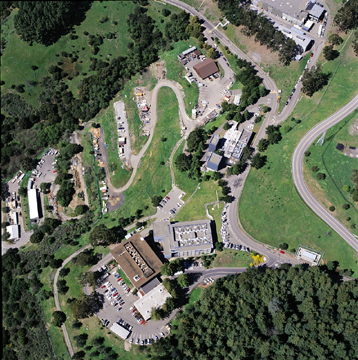 |
Lab photographer Roy Kaltschmidt has recently completed an aerial photo shoot of Berkeley Lab and surrounding areas. Thumbnails of 99 photos such as this one (shot from above NCEM and the future site of the Molecular Foundry) are available online in the Photo Lab Gallery (click on "Aerials of the Lab”). The first half are from a previous year, with the current ones at the end. For more information or additional images, email the Photo Lab at photo@lbl.gov.